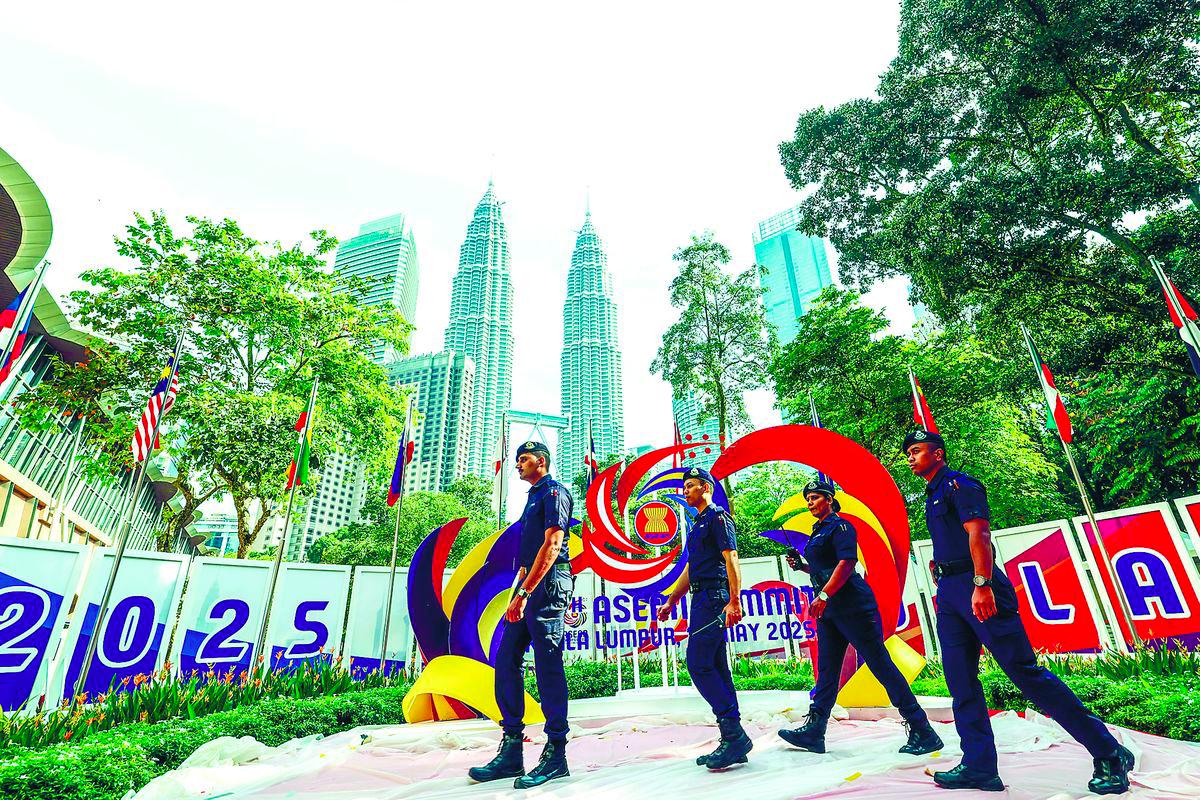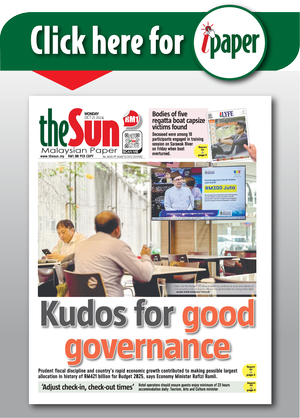WITH the clock ticking down on President Donald Trump’s expected attendance at the Asean Summit in Kuala Lumpur, opposition to the invitation has intensified on regional social media. However, none of the mainstream media, especially in the West, have seen it newsworthy to report it.
The calls from many Asean social media commentators for the bloc to withdraw its invitation to Trump stem from a mix of historical precedent, current economic and geopolitical anxieties and a rejection of his political style and policies.
These concerns can be discerned in several key areas:
Multifaceted economic impacts
Trump’s tariff war is arguably the most potent and immediate threat to Asean’s near-to-medium-term economic outlook. While internal challenges are significant, the US-driven global trade war would be an exogenous shock of a magnitude that could easily overshadow them and become the dominant negative factor for the region’s development.
Broken links: Asean is a critical node in global supply chains, particularly in electronics, automobiles, wood products and textiles. Many products are manufactured across Asean, China, other parts of Asia and Europe, with components crossing borders multiple times. The tariffs initiated by Trump have disrupted this complex network and made it more expensive and logistically chaotic.
Increased production costs: Companies have to deal with higher costs for imported goods and components, squeezing profit margins and forcing costly and rapid reconfigurations of their supply chains.
Global and regional slowdown: The IMF and World Bank have downgraded global growth forecasts due to the trade war. A weaker global economy means less demand for Asean’s exports, reduced earnings, greater fiscal challenges, rising unemployment and worsening of poverty across the region.
Commodity price volatility: The uncertainty has led to fluctuations in global commodity prices, affecting key Asean agrarian sectors and rural populations.
Disruption and “Maga” diplomacy
Asean’s central principle is consensus and neutrality. The bloc operates through careful and quiet diplomacy, avoiding public confrontation and maintaining a balance between major powers.
Trump’s disruptive style: Commentators point to his previous performances at international forums (like the G7 and North Atlantic Treaty Organisation) where he openly berated allies, dismissed multilateralism and prioritised bilateral transactional deals. They fear he would use the Asean summit as a stage to:
Publicly pressure individual leaders on trade deficits or security commitments;
Force a binary “with us or against us” choice regarding China, which Asean fiercely resists;
Disrupt the carefully crafted, consensus-based language of the summit’s final communique.
Perception of disregard and disrespect: His past behaviour, such as skipping key Asean-related meetings during his previous presidency, has left a perception that he does not value the member organisation or its leaders. Inviting him back is seen as rewarding this dismissive and arrogant attitude.
Damage to Asean’s centrality and cohesion
“Asean centrality” is the cornerstone of the bloc’s foreign policy – a long-held and repeatedly reaffirmed position that Asean should serve as the primary driving force in shaping regional architecture and geopolitics. This underpins Asean’s fear and rejection of anti-China groupings such as QUAD and Aukus, which have been initiated by US policymakers to contain China in the Indo-Pacific region.
Undermining the bloc: Trump’s
well-documented preference for unilateralism over multilateralism or even bilingualism is a direct threat to this concept. By dealing with countries
one-on-one in the tariff war, he is
seen as weakening Asean’s collective bargaining power.
Creating division: Commentators fear he will exploit existing divisions within Asean (for example, between claimants and non-claimants in the South China Sea) to benefit the US, thereby fracturing the unity that is essential for the bloc’s wellbeing and relevance.
Concerns over volatile and unpredictable agenda
Unlike a traditional political leader, Trump’s agenda is highly personal and unpredictable. This is the consensus not only of foreign governments and allies but also of his domestic opposition in the US.
Focus on grievances, not cooperation: There is a concern that he is not coming to discuss regional cooperation on climate, digital economy or infrastructure, or any of the region’s concerns but to air threats and grievances about trade, demand support for his political narrative or launch new verbal attacks on China.
The “Trump show”: The summit could be hijacked and focus on Trump himself – his statements, controversies and feuds – rather than on the substantive challenges and issues facing Southeast Asia. This diverts attention from Asean’s own goals and priorities.
Ideological and normative opposition
Many in Southeast Asia’s civil society and among the educated youth are aligned with liberal democratic values. However, they are against any form of external pressure on how these values are manifested and reject attempts by outside forces seeking to impose their version on other societies.
The “Trumpism” brand: Trump’s political brand is associated with policies and rhetoric that are unpopular with these segments.
Climate change denial: This is a critical issue for vulnerable Asean nations like Vietnam, the Philippines and Indonesia.
Authoritarian sympathies: His praise for strongmen and autocrats
is seen as undermining democratic movements and human rights in the region.
Divisive rhetoric: His comments on race, religion and immigration are viewed as contrary to the pluralistic character of many Southeast Asian societies.
Legitimising a figure they oppose: For these commentators, inviting Trump is seen as legitimising a figure many view as a threat to global stability and democratic norms. They do not want their region to be a platform for his political dominance and any new form of American hegemony.
The domestic US political context
The invitation is not happening in a vacuum.
Legal troubles: Trump is currently a defendant in multiple criminal and civil cases. Some commentators argue that
it is inappropriate to extend a state-level invitation to a figure facing such serious legal charges.
Political instability: Inviting a leader who continues to challenge the legitimacy of US electoral institutions and is engaged in military action and acts of war against Venezuela and
other neighbouring countries in Latin America is seen as injecting US domestic and foreign policy political turmoil into the Asean summit.
Conclusion: Clash of values and geopolitical visions
In summary, the call to withdraw the invitation is a reaction to the profound mismatch between the “Asean way” (consensus, quiet diplomacy, neutrality and institution-building) and the “Trump Way” (transactional, unilateral, confrontational and personality-driven).
For social media commentators and opponents against the visit, Trump represents volatility, disrespect for institutional norms and standards – a forced choice in the US-China rivalry that Asean member countries (except for one or two countries) would prefer not to be entangled in and what is being seen as the latest manifestation of American hegemony in Maga (Make America Great Again).
They believe his presence can:
Undermine Asean’s cohesion and centrality.
Shift the focus from regional concerns and cooperation to US politics and geopolitical confrontation with China.
Legitimise a foreign policy and political style they find damaging to regional and global stability.
Therefore, they see disinviting him not as an act of hostility towards the US but as an act of protection for Asean’s own interests and principles.
The reality facing opponents of Trump’s visit is that it is almost certain
to proceed. A disinvitation may be seen as diplomatic harakiri for Asean. Therefore, the better strategy is to encourage Trump to play a positive role in supporting the bloc’s peaceful and sustainable development by curtailing American foreign policy and economic actions aimed at bullying and exploiting the organisation’s member nations.
One recent positive example is the outbreak of armed conflict between Thailand and Cambodia. The breakthrough ceasefire was the result of a coordinated effort. Malaysian Prime Minister Datuk Seri Anwar Ibrahim played a central role as the host and mediator while Trump, according to some sources, is said to have applied diplomatic and economic pressure credited with pushing the parties to agree to a truce.
On its part, Asean should also, at
the summit, explore the possibility of playing a mediator role in the current US-China trade conflict.
Whilst Asean’s primary focus should be on shielding its economies from the collateral damage of the trade war
and strengthening its own regional resilience, Asean actions and strategic importance can create important indirect pathways to influence the broader dynamic of deals that can benefit member countries now facing Trump’s tariff bazooka.
Lim Teck Ghee’s Another Take is aimed at demystifying social orthodoxy. Comments: letters@thesundaily.com









